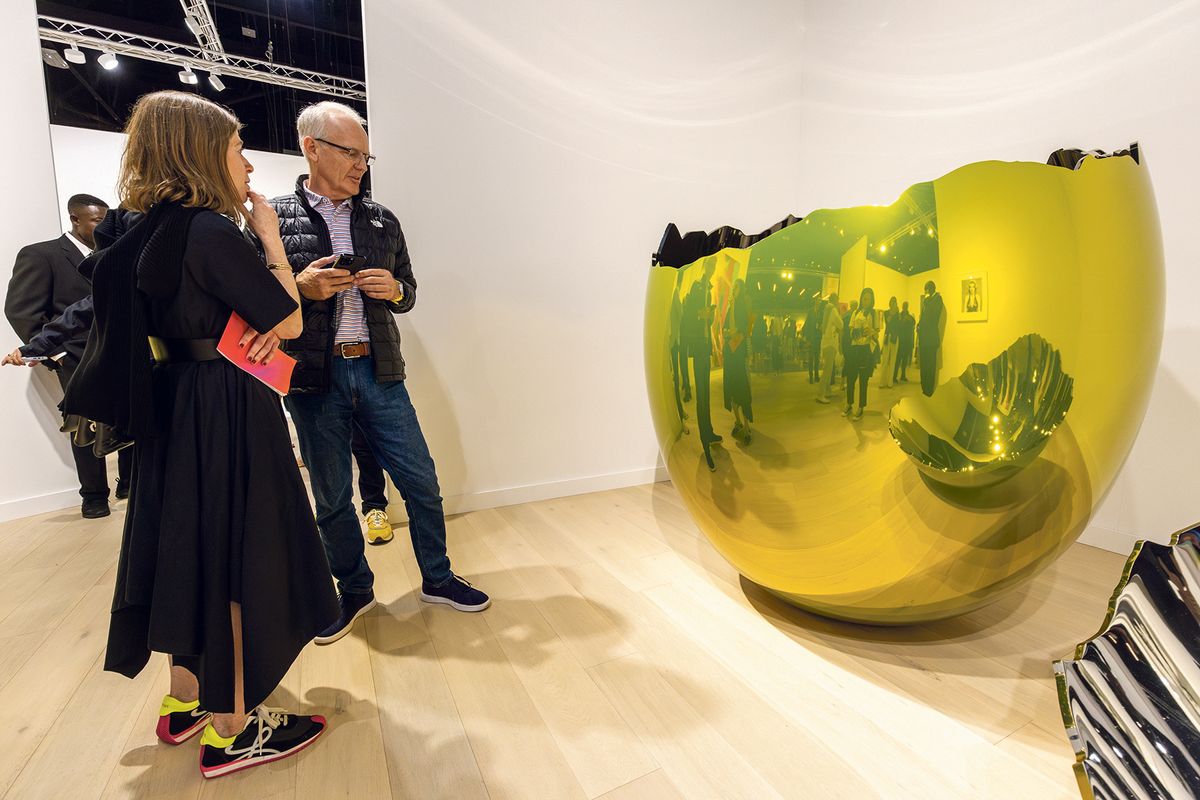A market-wide show of resilience, or a collective display of faking it until you make it? That was the question hovering over the first VIP day of Art Basel in Miami Beach on Wednesday. Although the final answer will not become clear until later, results in the early hours of the fair gave reason for at least some measured optimism.
Despite a nearly year-long market correction that has chastened many in the trade, the convention centre’s aisles were abuzz shortly after doors opened. Anyone ignorant to the broader market context would have had a difficult time detecting much anxiety. Still, conversations reaffirmed that the latest iteration of the fair is taking place in a more discerning environment than even last year’s edition, when the cracks in the trade were beginning to show.
“It’s a slightly more selective market. For us, that’s not a bad thing because we have a lot of things that are really canonised,” says Nick Olney, the president of Kasmin gallery. “We’re not aiming to push markets into some really hot streak, we’re really building things for the long term.”
Kasmin’s stand, larger than in previous years, features works by a wide range of artists, from the institutional fixtures Alex Katz and Judith Bernstein to the ascendant American artists Cynthia Daignault and vanessa german. The gallery made several sales in the opening hours, from $1.4m for Katz’s Leigh (2007) to $50,000 for 31-year-old Sara Anstis’s The tree surgeon (2023).
Several other blue-chip stalwarts were rewarded for soldiering on, albeit not at market-recalibrating levels. Thaddaeus Ropac placed three works in the seven-figure range by early Wednesday afternoon, particularly notable given the gallery’s long-time refusal to presell the pieces bound for its stands. Robert Rauschenberg’s Copperhead-Bite IX / ROCI CHILE (1985) led the pack at $1.7m, while Georg Baselitz’s Alles fällt vom Tisch (2020) and Grüße aus Dinard (2023) sold for €1.5m and €1.2m, respectively.
Gladstone Gallery placed $2.2m worth of works in the fair’s first two hours: a pair of Keith Haring works on paper for $950,000 and $650,000, Amy Sillman’s painting Machine (2023) for $450,000 and an untitled acrylic-on-archival-print work by Arthur Jafa for $150,000. Pace Gallery also closed multiple deals for six-figure prices, including Isamu Noguchi’s Plus Equals Minus (around 1945-79) for $450,000, a painting from the Korean artist Lee Kun-Yong’s Bodyscape series for $250,000 and multiple editions of Lynda Benglis’s 2023 bronze sculpture QT for more than $200,000 each.
Lehmann Maupin did similarly well with international artists and buyers alike. Teresita Fernández’s Dark Earth (Reservoir), a 2023 wall-based work, went to prominent private collectors in Europe for between $375,000 and $425,000. Lee Bul’s Perdu CLXXXVII (2023) is bound for a Hong Kong-based collection at a price in the $250,000 to $300,000 range. The gallery also placed a piece by the Brazilian duo OSGEMEOS, on show in the fair’s Kabinett sector, for $250,000 with US collectors.
Opening-hours demand went beyond the canonical names, with some young artists’ work flying off the stands. Perrotin, which split its large stand between a solo presentation of new paintings by the fast-rising California-based artist Emma Webster and a group presentation of the gallery’s other artists, also found swift success. All eight of Webster’s paintings, of climate-change-induced apocalyptic landscapes adapted from the artist’s own digital models, were placed by early afternoon, at prices from $80,000 to $175,000 each. The gallery also found buyers for works by Jason Boyd Kinsella, Alex Gardner and Xiyao Wang, at prices ranging from $65,000 to $115,000, as well as an Emily Mae Smith canvas (priced $200,000 to $300,000).
Setting aside sales, the exposure provided by a mega-fair like Art Basel in Miami Beach remains irreplaceable for modestly sized dealers. “This is a place that is key for us in terms of developing our programme and developing our collector base,” says Omayra Alvarado-Jensen, the executive director of the Bogotá- and New York-based gallery Instituto de Visión, which is selling works by Latin American women artists, ranging from $5,000 to $60,0000.
“It’s a tighter market,” one New York-based adviser said early on preview day. “Dealers who play it safe, they’re boring everyone. The ones who are willing to say, ‘This is my eye, this is my vision’, they do really well.”


